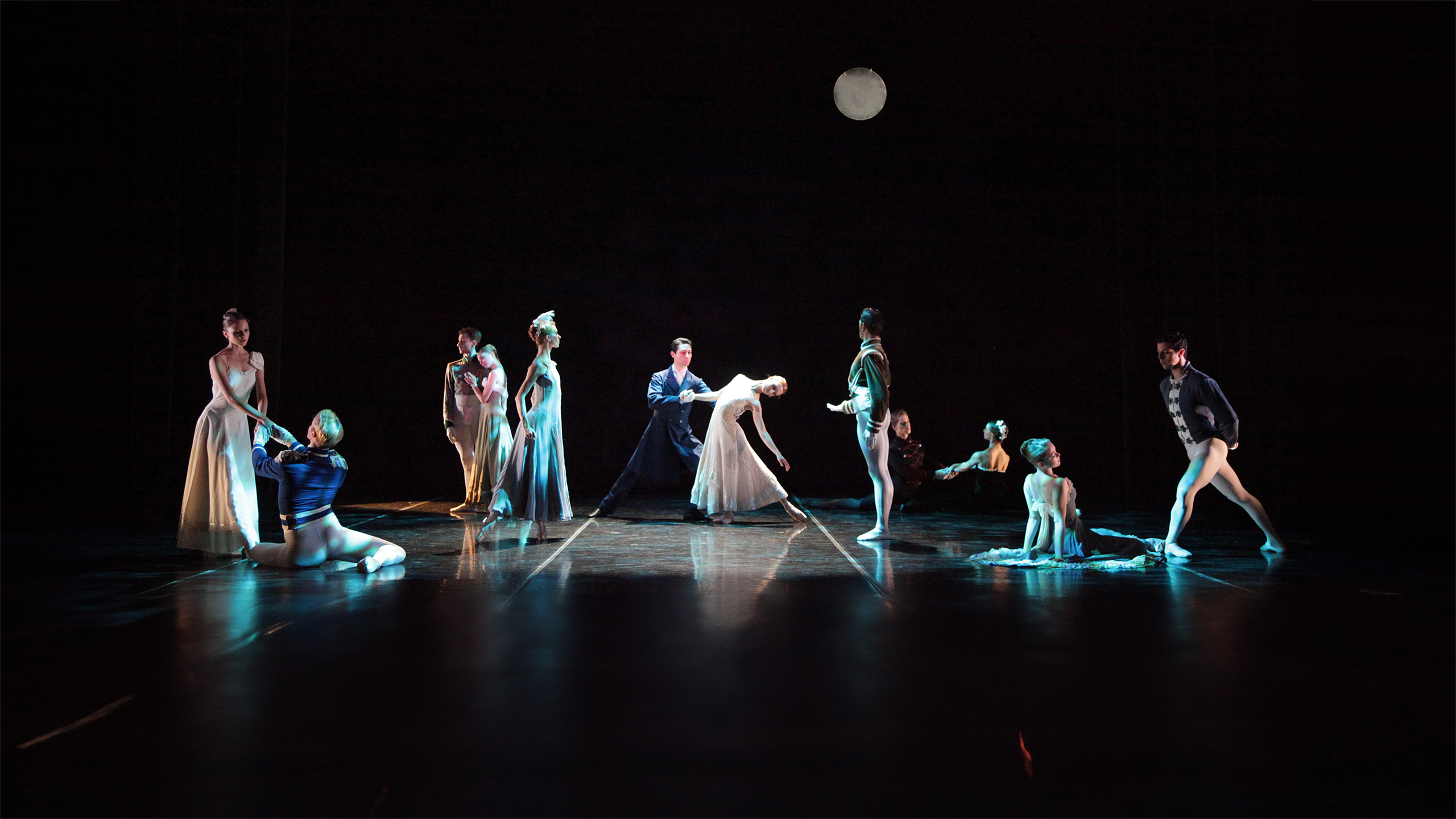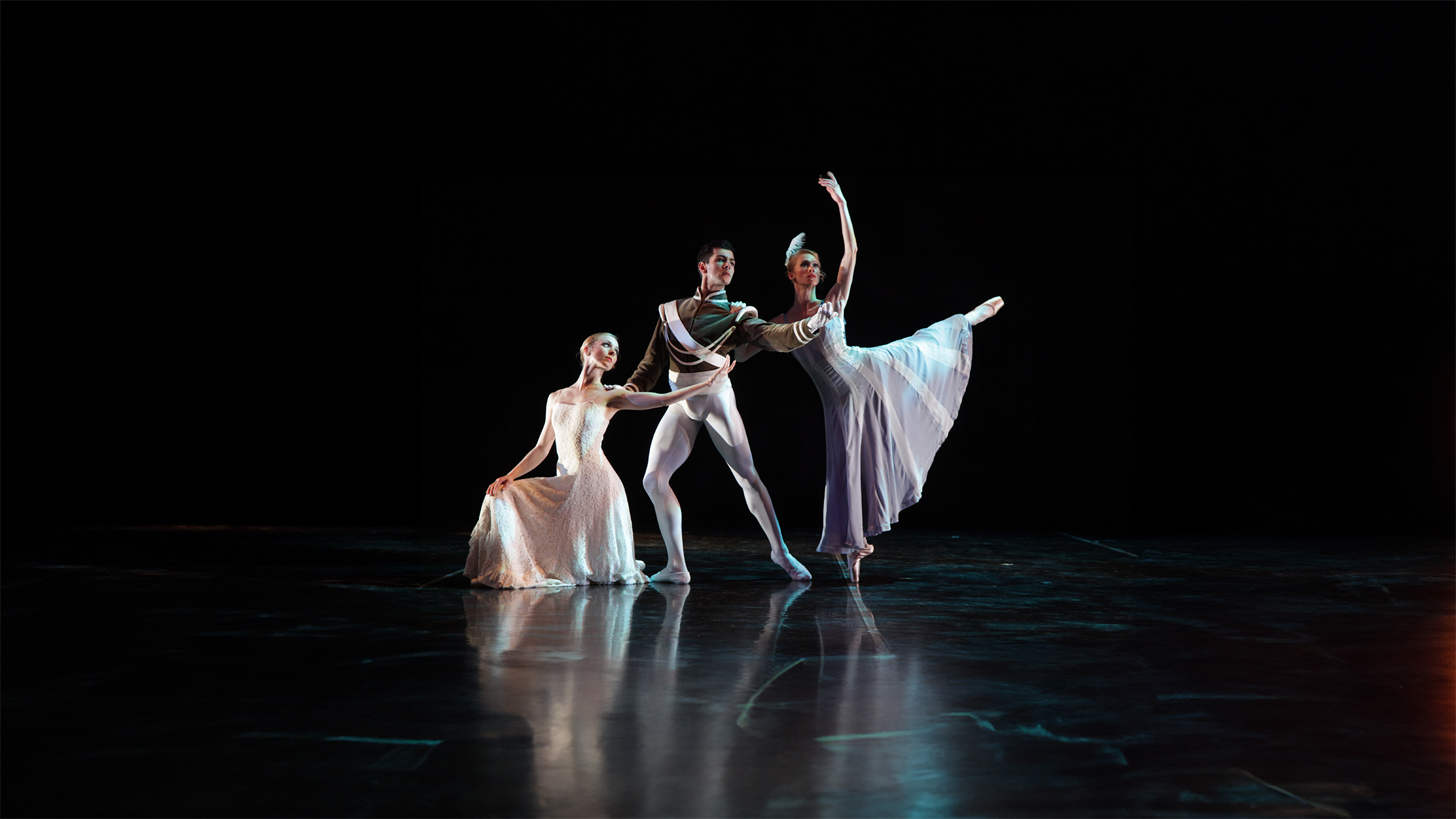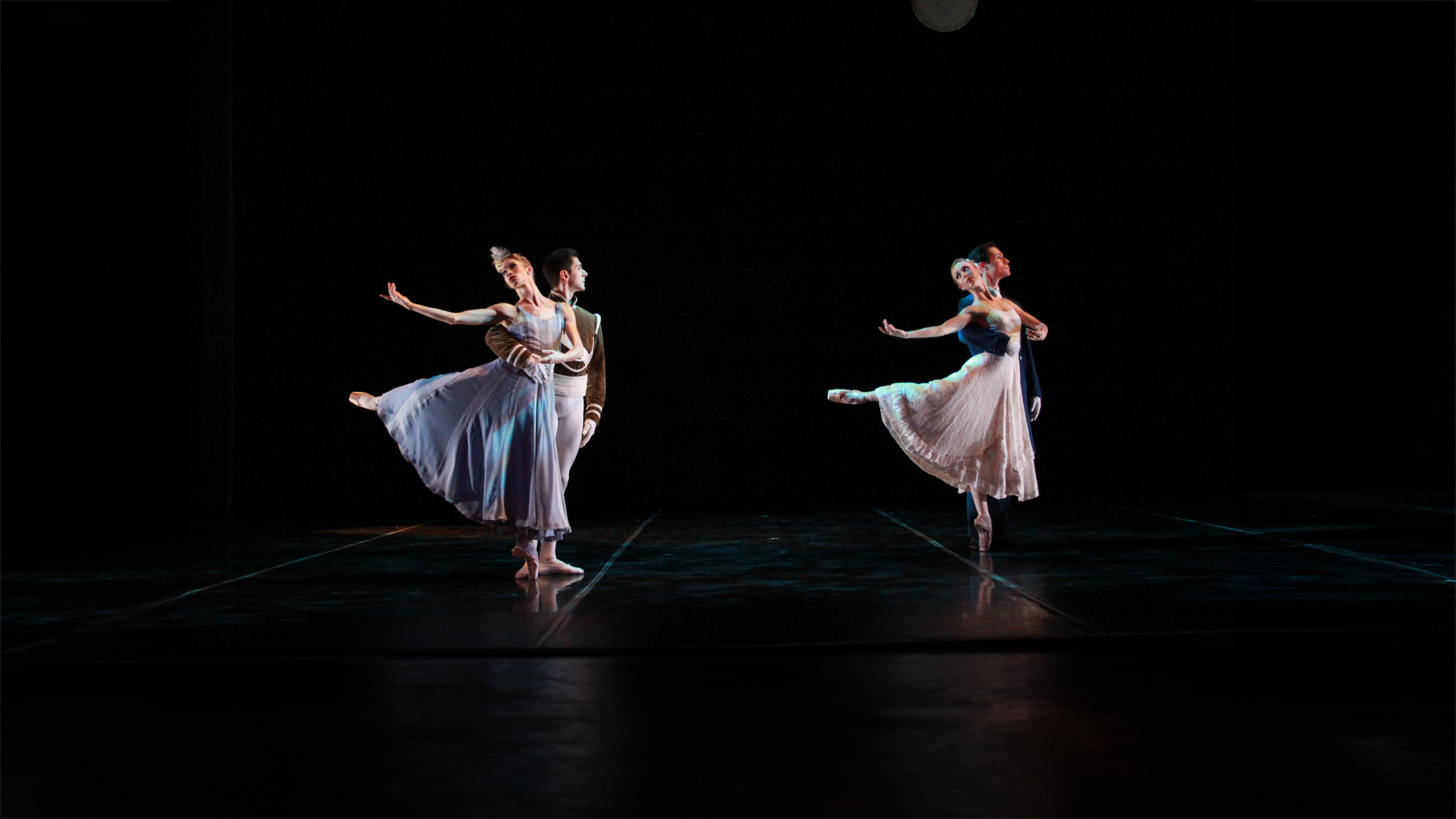Antony Tudor
Premiered January 26, 1936, by Ballet Rambert
The Sarasota Ballet Performing Antony Tudor’s Lilac Garden | Photo by Frank Atura
The Sarasota Ballet Performing Antony Tudor’s Lilac Garden | Photo by Frank Atura
The Sarasota Ballet Performing Antony Tudor’s Lilac Garden | Photo by Frank Atura
Lilac garden
Antony Tudor’s original program notes for Jardin Aux Lilas are brief: Caroline, on the eve of her marriage to the man she does not love tries to say farewell to her lover at a garden reception. In the end, she goes off on the arm of her betrothed with hopelessness in her eyes.”
The ballet is set in the England’s Edwardian era and is steeped in the conventions of the beginning of the twentieth century. The curtain opens on a pre-wedding party in a moonlit garden, hedged by lilacs. Caroline, the hostess, is about to enter into an arranged marriage to a man she does not love (The Man She Must Marry). Another man (Her Lover), with whom Caroline is deeply in love, is a guest at the party. In their youth they had always assumed that they would marry.
The fourth principal character (An Episode in His Past) is a fashionable, about-town woman and former mistress of Caroline’s fiancé. She appears unexpectedly upon the scene.
The ballet portrays private feelings submerged in public decorum, though throughout the course of the evening, brief and tempestuous moments of true emotion—of longing and regret—break through the artifice.
Created in 1936, Jardin Aux Lilas is one of Tudor’s most important works. It broke from the convention of using fanciful characters or settings in ballets, presenting instead a situation that could have been drawn from one’s life experience. As repetiteur Donald Mahler notes, the essence of Tudor’s ballets is that the “people and motivations are real—there is an honesty in doing Tudor.”
Rooted in pure, classical dance, Tudor’s choreography has also been characterized as honest, with no extraneous steps or movements. Each movement is critical to the work: each gesture must have intention and the dancer must be able to convey that intention. The result is a ballet is dense with detail and meaning, which may not always be seen on an initial viewing. The first movement of the ballet, for instance, is Caroline’s quiet intake of breath. It’s mirrored in the last, as she exhales.
Mahler also describes movement in the ballet as perfectly mated to the music; in fact Tudor’s intense musicality is a hallmark of all of his works. For Jardin Aux Lilas he chose Ernest Chausson’s Poeme (Op. 25) for violin and orchestra. It has no formal structure but rather has been called “rhapsodic and moody”—perhaps an expression of Chausson’s own tendency toward melancholy and introspection. It was initially rejected by publishers who thought it “bizarre” and too difficult to play, however at its Paris premiere in 1897 the audience felt differently, giving it a long ovation. Today it is a staple of the serious violinist’s repertoire and has been recorded by numerous performers, including Joshua Bell and Itzhak Perlman.
Chausson (1855-1899) was a French Romantic composer who studied under opera composer Jules Massenet. He wrote 39 opus-numbered works, one opera, Le Rois Arthus (King Arthur), one symphony (Symphony in B-flat) and a haunting song cycle, Poeme de l’amour et de la mer.He was acquainted with a number of the great artists of his day, including Claude Monet, Claude Debussy, Auguste Rodin and Edgar Degas. He died tragically young, at the height of his career and talent.
It certainly needed Marie Rambert’s inspired gift for talent spotting to recognize the potential genius of 19-year-old William Cook (born 1908 in London), an invoice clerk at Smithfield Market. Dance-mad, stage-struck, and determined, he came to Rambert at the suggestion of Cyril Beaumont for ballet lessons after his day job ended and stayed to become her stage manager, assistant teacher, pianist, and general factotum. Despite this late start, Antony Tudor, as he called himself professionally, rose rapidly through the 1930s to become the most serious British choreographic rival to Frederick Ashton, another Rambert discovery who moved from her Ballet Club to a future with Ninette de Valois’ emerging Vic-Wells Ballet.
Tudor’s 1931 choreographic debut Cross-Garter’d (based on Shakespeare’s Twelfth Night) earned praise from Massine and was followed by more ballets, including Lysistrata, Adam and Eve (1932) and The Planets (1934) before the mature successes of Lilac Garden (1936) and Dark Elegies (1937), and the more entertaining Judgement of Paris and Gala Performance (1938).
In 1938, chafing under Rambert’s demands, Tudor formed London Ballet with Andrée Howard, Agnes de Mille, and his lifelong partner Hugh Laing. In 1939, as the war engulfed Britain, Tudor left London Ballet in the hands of Peggy van Praagh and accepted Lucia Chase’s invitation to join the newly formed Ballet Theatre in New York. He remained the Resident Choreographer for ten years, restaging some of his earlier works and creating new ballets, including the seminal Pillar of Fire (1942).
Tudor retired from dancing in 1950 to direct the Metropolitan Opera Ballet School and teach at The Juilliard School and UCLA while continuing to choreograph works for the New York City Ballet (1951-52) and the National Ballet of Canada. He was Artistic Director of the Royal Swedish Ballet (1963-64) and continued to travel worldwide, creating ballets, teaching, and inspiring widely, rejoining the American Ballet Theatre as Associate Artistic Director in 1974. Among his later major works is The Leaves Are Fading (1975) to elegiac Dvořák music.
A committed Zen Buddhist, Antony Tudor succumbed to a heart attack on Easter Sunday, 1987, and died, greatly respected, at the age of 79 in New York. As one of the 20th century’s most important choreographers, his work has been characterized as psychologically, emotionally, and dramatically profound, full of a deeply felt understanding of the human heart and condition.
Ernest Chausson was born in Paris to a prosperous bourgeois family at 25, Chausson began attending Jules Massenet’s composition classes at the Paris Conservatoire. He had already composed some piano pieces and songs; however, the earliest manuscripts that have been preserved are those corrected by Massenet. In 1882 and 1883, Chausson made the pilgrimage to Bayreuth to attend the operas of Wagner. On the first of these journeys he went to see the premiere of Parsifal.
Chausson’s work is commonly divided into three periods. The first was dominated by Massenet and exhibits fluid and elegant melodies. The second period, dating from 1886, is marked by a more dramatic character, deriving partly from his contacts with the artistic milieux in which he moved. The third period dates from his father’s death in 1894 and was influenced by his reading of the symbolist poets and Russian literature, particularly Turgenev, Fyodor Dostoevsky and Leo Tolstoy.
Chausson’s work is deeply original, but it does reflect some technical influences of both Franck and Wagner. His compositional idiom bridges the gap between the Romanticism of Massenet and Franck and the Impressionism of Debussy. He completed one opera, Le Roi Arthus (King Arthur). His orchestral output was comparatively small, but significant. The works of his that involve orchestra include the Symphony in B-Flat, his sole symphony, Poème for violin and orchestra, an important piece in the violin repertoire and the dramatic mélodie, Poème de l’amour et la Mer.
From 1885 until his death in 1899, Chausson was secretary of the Société Nationale de Musique. He received many of the Paris artistic elite in his salon, including the composers Henri Duparc, Gabriel Fauré, Claude Debussy and Isaac Albéniz, the poet Stéphane Mallarmé, the Russian novelist and playwright Ivan Turgenev and the impressionist painter Claude Monet. Chausson also assembled an important collection of impressionist art.
At the age of 44, Chausson died as a result of an accident. He is buried in Père Lachaise Cemetery in Paris.
Raymond Sovey (1894-1966) was a costume, scenic, and lighting designer for many Broadway productions. Sovey studied art at Columbia University. In 1923 he made his debut as a scenic designer for the Theatre Guild’s production of St. Joan. Sovey was especially prolific during the 1930s, working on shows such as Twelfth Night (1930) and The Damask Cheek (1942). He also designed the Inland Ice Tray Exhibit in the General Motors Building at the 1939 New York World’s Fair. He continued to design for the theatre until 1961. He died in 1966 after retiring to Columbus, Ohio.
Hugh Stevenson was born on 30 March 1910 in Nottingham, Nottinghamshire, England, UK. He was a costume designer, known for The Immortal Hour (1939), Le lac des cygnes (1937) and The Insect Play (1939). He died on 16 December 1956 in Marylebone, London, England, UK.
Ethan Vail is originally from Indiana and has been the lighting designer for various art forms. His passion for lighting dance truly began in his college, Purdue University, and since then he has lit numerous ballets ranging from full length works like Johan Kobborg’s La Sylphide to one-act ballets including masterpieces by Ashton, George Balanchine, and Sir Kenneth MacMillan. He has also created original designs for choreographers Gemma Bond and Ricardo Graziano. Ethan’s work has also been seen in various theatres around the country including Westcoast Black Theatre Troupe, Urbanite Theatre, and Asolo Repertory Theatre. Highlights of his career thus far include winning the 2013 U.S. Institute for Theatre Technology’s Young Designers, Managers & Technicians Award; and lighting The Sarasota Ballet’s 2024 performances at The Royal Opera House in London.


